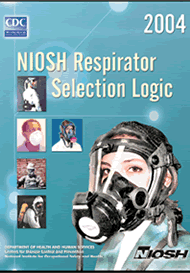Chapter IV. Escape
Respirators
Escape devices have a single function: to allow
a person working in a normally safe environment sufficient time to
escape from suddenly occurring respiratory hazards. Given this
function, selection does not rely on assigned protection factors.
Instead, these respirators are selected based on a consideration of
the time needed to escape, and the likelihood of IDLH or oxygen
deficiency conditions. Escape devices can be separated into two
categories: air-purifying respirators and self-contained breathing
apparatus.
Air-purifying respirators remove contaminants from the air by
sorbent and/or filter media, but because they do not provide air,
these respirators cannot be used in an oxygen-deficient atmosphere.
Escape capabilities of air purifying respirators can be summarized
as follows:
| |
• Air-purifying respirators with particulate
filters or chemical cartridges are approved for escape from
atmospheres containing specific contaminants in concentrations
that are not immediately dangerous to life or health (IDLH)
and oxygen content of at least 19.5% by volume. This includes
half and full facepiece respirators that are routinely used in
many work environments. Mouthpiece-type cartridge respirators
(TC-23C) are approved for escape only.
|
| |
• Air-purifying respirators with canisters (TC-14G)
include the escape gas mask (canister) respirator, the gas
mask (canister) respirator, and the filter self-rescuer.
|
The escape gas mask consists of a half-mask or a mouthpiece
respirator. The mouthpiece respirator can be used for short periods
of time to escape from low concentrations of organic vapor or acid
gas. The escape gas mask, which utilizes a half-mask, filters
contaminants from the air. These respirators may also be used to
escape from low concentrations of organic vapor or acid gas, but not
from oxygen deficient atmospheres. Escape gas mask respirators
equipped with full facepieces can also be used for escape from IDLH
conditions but not from oxygen-deficient atmospheres. These
respirators may be used for escape from contaminant concentrations
above the IDLH value provided that the maximum use concentration
(MUC) for the canister is not exceeded and adequate oxygen (=19.5%)
is present. Note that not all gas masks provide protection against
carbon monoxide (CO). Check the certification to determine if the
respirator is specifically certified for use against levels of CO
that exceed the exposure limit. Gas masks with full facepieces are
also acceptable for routine use in non-IDLH atmospheres. Gas masks
with mouthpieces are for escape only. No air-purifying device is
suitable for escape from a potentially oxygen-deficient atmosphere.
The filter self-rescuer unit is the mouthpiece device, which is
designed to protect specifically against atmospheres with not more
than 1% carbon monoxide. The filter self- rescuer is normally used
in mining.
A new type of air-purifying escape hood that fits over the head
and seals at the neck has been developed specifically for escape
from chemical, biological, nuclear, or radiological exposures
associated with terrorism events. This type is not discussed further
here as terrorism-related selection is beyond the scope of this
document. See http://www.cdc.gov/niosh/npptl/interesc0404.html
for additional information
A self-contained breathing apparatus (SCBA) provides air to the
user for escape from oxygen-deficient environments. Escape SCBA
devices are commonly used with full facepieces or hoods and,
depending on the supply of air, are usually rated as 3- to 60-minute
units.
Self-contained self-rescuer (SCSR) devices have been approved by
MSHA/NIOSH for escape from mines, but these devices may also have
application in other similar environments. SCSRs are mouthpiece
respirators that provide a source of oxygen-enriched air for up to
60 minutes. SCSRs are normally stored in mines and used for
emergency escape from mine disasters. All SCBA devices can be used
in oxygen-deficient atmospheres.
When selecting escape apparatus, careful consideration must be
given to potential eye irritation. This consideration is important
for determining whether a gas mask or SCBA equipped with a full
facepiece should be selected rather than a device equipped with a
half-mask or mouthpiece.
The majority of gas masks or escape gas masks can be used in
situations involving gases, vapors, or particulates. For escape from
particulate-contaminated environments, an air-purifying element must
be selected that will provide protection against the given type of
particulate.
In addition to contaminants and concentration levels, the time to
escape the hazard must be considered. For example, escape SCBA can
have rated service lives of 3 to 60 minutes.
NIOSH intends to review the selection criteria for escape
respirators and will provide additional guidance in future revisions
of the RSL.
| 

